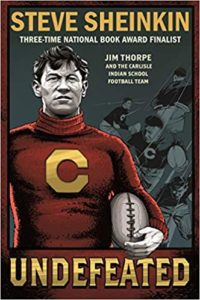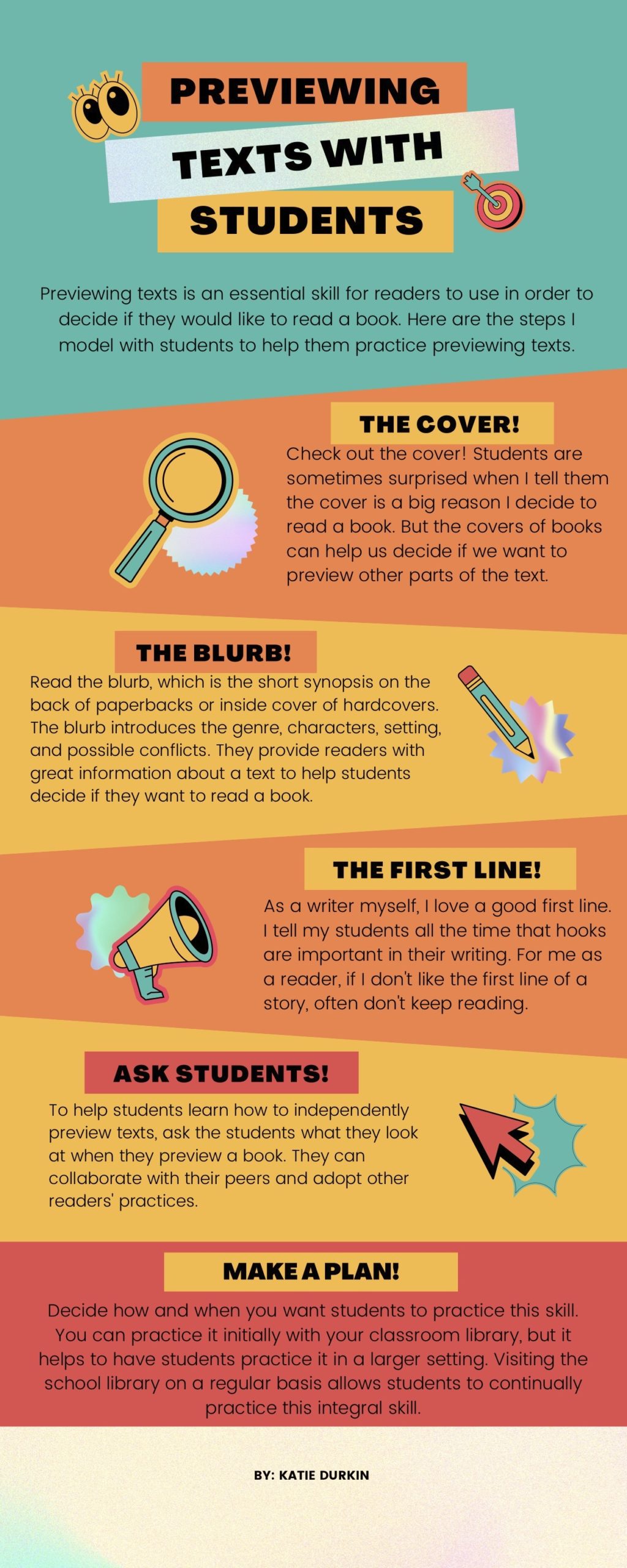School Libraries Build Lifelong Reading Skills
 By Katie Durkin
By Katie Durkin
I distinctly remember the day one of my students asked which bin they were allowed to use to check out books from my classroom library.
As all of my titles have always been organized by genre with various shelves and displays – I was surprised to hear this question. I didn’t have any books in bins in my classroom.
This student explained he was only allowed to read certain books from certain bins in previous grades and proceeded to tell me his ‘label,’ signifying which books were deemed appropriate for him to read.
Conversations like this one have occurred year after year with my students who aren’t sure how to navigate my classroom library, and in turn, our school library. They don’t know about “browsing” because they’ve been relegated to choosing reading material from a particular bin with a particular label.
Learning reading skills in the school library
Because of these conversations, I have made it a priority to teach students how to browse for books in a library – especially our school library. My 7th grade students this year haven’t been able to fully use a classroom or school library for a long time. With the mitigation strategies in place for COVID-19, books were placed on hold from the school library and directly delivered to classrooms. Many classroom libraries were not used at all.
This year my students will be visiting our Library Learning Commons, or LLC, once a month to browse for books. There are three goals I have for students: (1) listen to book recommendations from our school library media specialists; (2) browse the stacks to preview books of interest to take home, and (3) build the skills they need to independently find books of choice in the future.
Monthly school library visits
Coordinating with my amazing library media specialists, I plan to visit the school library at least once a month this year. These visits usually correspond with the end of a unit, where students are reflecting on previous reading goals and setting new ones.
I arrange each visit weeks ahead of time to make sure it fits within my schedule for curricular requirements and to make sure the library staff will be available for book talks and to answer questions from students.
For each visit, we follow a similar routine. To start, our school librarians usually pull books from the stacks related to each unit. We spend the first 15 minutes with our librarians, where they “book talk” high-interest texts. It is important for students to listen to recommendations from our specialists because they know these books and understand students’ interests.
These model book talks pique students’ interests, and in many cases students know exactly what book they want to check out before the book talks are over. Often multiple copies of a title are available, so more than one student can read the book at the same time.
Reading suggestions provided by librarians

For this class, the school librarians “book talked” Undefeated: Jim Thorpe and the Carlisle Indian School by Steve Sheinkin, as well as Rising Above: How 11 Athletes Overcame Challenges in Their Youth to Become Stars by Gregory Zuckerman.
By the end of that particular class, all the copies of these books were checked out. My students enjoy listening to adults discuss their own reading life while they also provide a plethora of recommendations.
A whole library to explore!
Book talks from the school librarians are an essential part of our visits, but I also want students to practice skills needed to browse for books independently. This means leaving time for them to browse different options for the unit as well as books of choice.
One skill I want my students to practice during this time is previewing a book. This is a skill that can be practiced throughout their school library visit to determine whether or not they want to check the book out. While students can practice previewing a text with myself, a library media specialist or a peer, my goal this year is to have each student be able to preview and choose books independently before school ends.

I teach students that previewing a book can be a very individual practice, based on personal preferences. I share the three things I look at when previewing a book:
(1) the cover,
(2) the blurb on the inside cover or back, and
(3) the first line of the story.
Many students are shocked when I admit that the cover is one of the things I look for in a good book to read for fun, but I believe covers are designed with purpose. While we may not be judging a book by its cover, we are looking for book cover clues that might pique our interest enough to want to read the text.
Previewing a text is a ‘mobile’ skill – one that helps students build the habits of lifelong readers. I want them to be able to transfer this skill to other places, such as public libraries and bookstores.
Students can adapt previewing to match their preferences
Before students are sent off to preview texts on their own, I remind students of the different ways they could preview a text, and we co-construct diverse previewing reminders. Some of my students will only read a blurb of a book if they like the title. Other students will look at the length of the book. One year a student told me they read the last chapter of the book first so they would have an idea of what happened at the end.
I don’t believe it matters what students look for when they preview the text. I want to make sure they have the skills to determine why they want to read a book and have the opportunity to practice this skill, especially in a larger setting like the school library.
I know that helping students learn how to independently navigate the classroom and school libraries will take time, but I also believe with continued practice and consistent visits to the school library this year, my students will be able to make good reading choices in the future – a develop some passion for book hunting.
By going to the school library, they also get the opportunity to explore various topics they may be learning in other classes. For example, in the Science class this year, a major unit for the students is ecology. They are learning about food chains and biospheres. The school library has many more options for learning about this topic than my classroom library.
The school library: An essential resource
I believe taking my students to the school library at least once a month is an important routine in my class, even though I have a robust classroom library. Both of these spaces enrich students’ reading lives, especially since they are able to offer students a myriad of options for their choices in reading.
In essence, the school library serves a similar function as classroom libraries in terms of leveraging students’ interests. But the school library has the space and broad subject-area expertise that I cannot always offer my students.
I want my middle schoolers to have the skills they need to be lifelong readers, and ready access to books is not always going to be part of their daily experience. Utilizing the school library now, and visiting it frequently, lets students learn from our librarians’ experiences with reading, while providing time to practice important skills they will need to grow as readers who understand the intrinsic value of books throughout a lifetime.
Katie Durkin (@kmerz610) has been teaching English Language Arts to middle school students for a decade and currently teaches 7th grade Reading Workshop at public Middlebrook School in Wilton, Connecticut.
Katie is a zealous reader of middle grades and young adult books and enjoys sharing her love and passion for reading with her students. She is a doctoral student at Northeastern University studying the impact of classroom libraries on middle school students’ reading engagement. She is also the 2020 recipient of the Edwyna Wheadon Postgraduate Training Scholarship from the National Council of Teachers of English.




































Good article, happy to read the activities written here are practiced in my library. I am feeling proud of being the Librarian, so much they do.